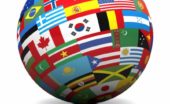Molly Minturn - My family is heartbroken to share that my father died in surgery on Monday, Feb. 10. It…
Year-end 2021 reviews and predictions for 2022
Written by Diana Thebaud Nicholson // January 12, 2022 // Nicholson musings and messages // Comments Off on Year-end 2021 reviews and predictions for 2022
Global Growth to Slow through 2023, Adding to Risk of ‘Hard Landing’ in Developing Economies
(World Bank) Following a strong rebound in 2021, the global economy is entering a pronounced slowdown amid fresh threats from COVID-19 variants and a rise in inflation, debt, and income inequality that could endanger the recovery in emerging and developing economies, according to the World Bank’s latest Global Economic Prospects report.
World Bank warns global economy faces grim outlook
(BBC) The global economy faces a “grim outlook”, World Bank president David Malpass has warned, as the aftershocks of the pandemic continue to weigh on growth – especially in poor countries.
4 January
Ian Bremmer: Top Risks 2022
#1 — No zero COVID
China, the primary engine for global growth, will face highly transmissible COVID variants without the most effective vaccines, and with far fewer people protected by previous infection. China’s policy will fail to contain infections, lead to larger outbreaks, and require more severe lockdowns.
#2 — A technopolar world
That’s a reference to the intensifying conflict between governments and the world’s largest tech companies over who will set the rules in the digital space that’s playing an ever-larger role in our lives and our politics.
#3 — US midterms
In November, Republicans will probably win back majority control of the House of Representatives – and maybe the Senate. If so, Democrats will view GOP control as the illegitimate result of a voter-suppression campaign, and Republicans will see victory as further evidence of 2020 election fraud. Public trust in American political institutions will take an even larger hit.
30 December
Elections to Watch in 2022
Next year’s contests are set to bring populist reckonings, parliamentary headaches, and a possible democratic crisis or two.
(Foreign Policy) From Colombia to Bosnia and Herzegovina to South Korea, 2022 is stacked with presidential and parliamentary elections that could fundamentally reshape their respective countries’ political systems—and destinies. And that’s not even counting what will be the world’s biggest election: not a national contest but legislative elections in the Indian state of Uttar Pradesh, whose some 200 million residents will decide whether the ruling Bharatiya Janata Party stays in power there for another five years.
Although each country’s context is unique, the stakes of each election follow remarkably similar trends.
In some countries, such as Brazil, Hungary, and the Philippines, voters will decide whether to grant Trumpian autocrats and their parties another term in office; in France, which narrowly avoided electing such a leader in 2017, 2022 may prove to be the year of a right-wing resurgence. Other elections, such as those in Costa Rica, South Korea, Colombia, and Kenya, feature incumbent presidents ineligible for reelection giving way to suspenseful races of extremes—though all candidates in these races will face the hurdle of a two-round runoff election. In Portugal, Australia, and Sweden, minority governments facing budgetary woes are gambling on elections to strengthen their coalitions. And in places such as Mali, Bosnia and Herzegovina, and Tunisia—which have each witnessed significant backsliding in the past year—elections will determine whether democratic institutions can live another day.
Heather Cox Richardson December 30, 2020
And so, we are at the end of a year that has brought a presidential impeachment trial, a deadly pandemic that has killed more than 338,000 of us, a huge social movement for racial justice, a presidential election, and a president who has refused to accept the results of that election and is now trying to split his own political party.
It’s been quite a year.
But I had a chance to talk with history podcaster Bob Crawford of the Avett Brothers yesterday, and he asked a more interesting question. He pointed out that we are now twenty years into this century, and asked what I thought were the key changes of those twenty years. I chewed on this question for awhile and also asked readers what they thought. Pulling everything together, here is where I’ve come out.
26 December
2022 look ahead: Arms race will dominate U.S. – China competition
Things will begin to heat up in two key dimensions
Admiral James Stavridis
(Nikkei Asia) The possibility of military activity ominously looms in many regions and it feels like the military balance-of-power is shifting in East Asia. What does 2022 hold in terms of the Pacific, especially in the vital U.S.-China relationship?
Things will likely be relatively quiet as the year begins in the run-up to the 2022 Winter Olympics in Beijing, as China seeks as little controversy as possible and wants to showcase its ability to run the prestigious events smoothly. Although displeased about what it perceives as significant human rights violations by Beijing against its Uighur population, Washington will settle for a “diplomatic” diplomatic — meaning no official delegation and certainly no President Joe Biden.
But after February comes and goes, and shortly after the last medals are handed out, things will begin to heat up. In two key dimensions, the U.S.-China competition will take center stage: a technological arms race of significant consequence alongside fresh diplomatic maneuvering by both Washington and Beijing.
As President Xi Jinping sails toward the consequential 20th National Congress of the Chinese Communist Party in the fall of 2022, he will want to be able to tout his accomplishments across sectors: cultural, economic, health, diplomatic, and, above all, militarily. These advances will help cement his ambition to serve at least another five-year terms, and are part of the long-range program to make China the world’s best military by midcentury, if not sooner. It also serves as an object warning to what the Chinese view as the “rogue province” of Taiwan. China’s efforts across all three lines will jump-start in 2022.
On the U.S. side, there will be significant effort expended in developing new military technologies and systems to deter China and to counter specific new capabilities fielded by the People’s Liberation Army.
Southeast Asia’s soaring exports fuel hopes of recovery in 2022
Central banks seen shifting to rate hikes to protect home currencies
Bloomberg: Central banks in 2022
Central banks are likely to spend 2022 heading in different directions.
As our new quarterly guide to 23 monetary authorities shows, the specter of inflation means the Federal Reserve, Bank of England and Bank of Canada look set to hike interest rates at some point in the coming 12 months.
On the flip side, their counterparts in the euro-area and Bank of Japan will probably keep trying to ignite demand in their pandemic-hit economies by holding rates at emergency lows.
As for China, it’s seen cutting its benchmark as officials try to cushion a slowdown in the world’s No. 2 economy.
John Cassidy: The 2022 Economy Looks Strong, but Beware the Known Unknowns
COVID and policy changes could radically impact growth, inflation, and the midterm elections.
(The New Yorker) Despite the rapid spread of the Omicron variant, the U.S. economy ended 2021 in strong shape. Holiday spending rose by 8.5 per cent compared with last year, according to a recent survey. In the four-week period that ended on December 25th, initial unemployment insurance averaged less than two hundred thousand a week, and reached the lowest level in more than a half century. Based on impressive numbers like these, the Federal Reserve Bank of Atlanta estimates G.D.P. growth of 7.6 per cent in the final quarter of the year, up from 2.3 per cent in the third quarter, when the Delta variant held back spending. The Conference Board, a business research group, reckons that over the whole of 2021 G.D.P. rose by 5.6 per cent, which would be the highest rate since 1984. What about rising inflation? These G.D.P. figures and projections are all adjusted for inflation: they account for rising prices. If such indicators prove correct, 2021 was the year of the fastest economic growth since Ronald Reagan declared that it was “morning again in America.”
The era of globalization has come to an end. We don’t yet know what replaces it
Doug Saunders’ commentary on the forthcoming book Slouching Towards Utopia by J. Bradford DeLong, economist and historian at the University of California at Berkeley (and a former U.S. deputy treasury secretary), excerpts from which he has been sharing. “You can tell a lot about historians’ views by where they place the beginning and end of the 20th century, and he is arguing for a “long twentieth century,” starting in 1870 and ending at some point after 2010 – the beginning and the end of the age of globalization.”
Outlook 2022: Recovery or Relapse?
Douglas Porter
(Policy) Amazingly, in light of the waves of uncertainty in 2021, the global economy came remarkably close to matching growth expectations, with China and Europe in particular landing right on top of forecasts. Precisely a year ago, we opined that “the global economy is expected to rebound 5.5% in 2021, and then advance another 4.0% in 2022” after the deepest plunge in the post-war era in 2020 (down more than 3%). In fact, we now estimate that the global economy snapped back 5.8% this year, and are penciling in 4.5% in 2022, before simmering down to 4.0% in 2023. To put those figures into some perspective, a typical year for the world economy in recent times would see growth just a bit above 3%. A keen observer would note that even with our call of a strong rebound in the coming two years that the level of activity would still be below its underlying trend by the end of 2023. Part of that shortfall reflects the simple fact that some of the loss on spending in the service sector in the past two years—such as on travel, entertainment, restaurants—may never be recouped.
But, similar to a year ago, our forecasts for the coming year are again shrouded in the relentless uncertainty surrounding the virus.Our best guess is that activity hits a serious air pocket around the turn of the year, notably in North America, before rebounding solidly through the middle portion of 2022. However, this is based on the ready recognition that there are still as many questions as answers on the new variant.
The other big cloud on the global outlook is hot inflation, and the need for policymakers to shift gears to cool prices. We would counter the caution with the point that there is also an upside risk to our growth projections, given immense pent-up demand for services, strong balance sheets among households and businesses, and the possibility of a bounce in some key sectors (e.g., autos) if supply chain issues improve.
If American democracy is going to survive, the media must make this crucial shift
Journalists stepped it up in 2021, but now we need a concerted effort
In the year since the Jan. 6 insurrection, mainstream journalists have done a lot of things right. They’ve published major investigations, pointed out politicians’ lies and, in many cases, finally learned how to clearly communicate the facts of what happened leading up to that horrendous riot at the U.S. Capitol — and what is happening now as pro-Trump Republicans steadily chip away at the very checks and balances that saved American democracy last year.
Much of this work has been impressive. And yet, something crucial is missing. For the most part, news organizations are not making democracy-under-siege a central focus of the work they present to the public.
… The Atlantic magazine — which positions itself as centrist rather than left-leaning — published an entire issue in December devoted to the topic of democracy under threat. The cover headline’s message was hard to miss: “January 6 was practice.” The cover story by Barton Gellman is headlined Trump’s Next Coup Has Already Begun.
But in general, this pro-democracy coverage is not being “centered” by the media writ large. It’s occasional, not regular; it doesn’t appear to be part of an overall editorial plan that fully recognizes just how much trouble we’re in. … Then, news leaders, show that you really mean it. Put that pro-democracy coverage in front of your paywall, just as you’ve done with much of your covid coverage. Put teams of reporters and editors on the subject. Label it in a defining and memorable way, as news organizations have done with “Spotlight” or “Watchdog” teams in the past.
4 startling polls you should read about Jan. 6
As the one-year anniversary of Jan. 6 approaches this week, news outlets are out with a spate of new polls showing how the siege of the Capitol has affected American politics.
With Donald Trump lurking, is the U.S. sleepwalking toward calamity?
In 2021, the world had no lack of bad actors.
As Christmas approached, Russian President Vladimir Putin had amassed an estimated 100,000 troops, 1,300 tanks and 1,800 pieces of artillery on the Ukraine border, and was demanding the West bend to his terms.
Through the fall, even as it was dismembering the last of “one country, two systems” in Hong Kong, Beijing ramped up its rhetoric about bringing Taiwan under its control. China carried out ominous military operations, sending so many fighter jets and bombers in Taiwan’s direction in October and November that the country had to scramble its defence forces each time.
The sabre-rattling further disturbed a world already made uneasy by a pandemic, supply-chain problems, and inflation. As the year ended, the prospect of China or Russia redrawing the map, by force of arms, hung over the planet.
The Democratic Threat to Democracy
Kemal Derviş
(Project Syndicate) Although the current trend of democratic backsliding has been framed as a competition between Western-style democracy and Chinese-style authoritarianism, the truth is more complicated. Today’s liberal democracies are more likely to succumb to illiberal majoritarianism than to a revolutionary vanguard that dispenses with elections.
What next? 22 emerging technologies to watch in 2022
New ideas can emerge seemingly overnight
(The Economist) The astonishingly rapid development and rollout of coronavirus vaccines has been a reminder of the power of science and technology to change the world. Although vaccines based on new mRNA technology seemed to have been created almost instantly, they actually drew upon decades of research going back to the 1970s. As the saying goes in the technology industry, it takes years to create an overnight success. So what else might be about to burst into prominence? Here are 22 emerging technologies worth watching in 2022
Bloomberg: SELF-SUFFICIENCY: 2021 saw countries push for greater self-reliance when it came to things like semiconductors. Broad supply bottlenecks may persist, accelerating plans to build domestic industry and shield national champions from overseas buyers, leading to rising protectionism. It’s not just chips that are at stake: There are renewed questions about energy dependence, for example.
Key reading:
– S. Natural Gas Faces Wild 2022 as Foreign Crises Exert Pull
– The Year Chip Shortages Changed the World
2021: a year of climate crisis in review
A look back at 12 months of key summits, devastating weather and alarming discoveries
by Bibi van der Zee
(The Guardian) The year began with a counting up of the damage after the catastrophic extreme weather events of 2020, from fires to floods. Looking at the US alone, California more than doubled its previous annual wildfire record with more than 1.7m hectares (4.1m acres) burned and Nasa concluded that 2020 had been the joint hottest year on record. The US’s Noaa and the UK Met Office put it in close second to 2016.
And 2021 – the year that would see the crucial UN climate summit held in Glasgow in November – was not showing signs of being much better. The continent of Africa had its warmest January on record, while torrential rains fell in Malaysia, leading to the evacuation of 50,000 people and the death of at least six. Meanwhile in Turkey there were fears that Istanbul would run out of water following the most severe drought in a decade.
ASEAN nations have every reason to dread 2022
Singapore the only bright spot as markets punish complacency



